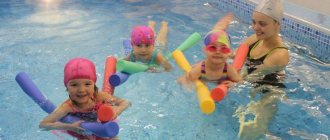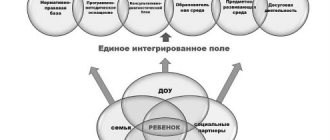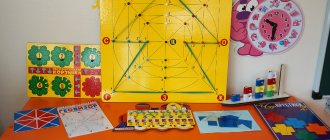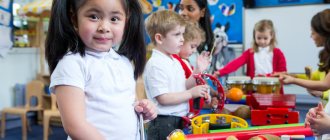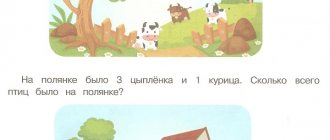Mathematics in kindergarten
Mathematics in kindergarten begins in the second junior group, where they begin to carry out special work on the formation of elementary mathematical concepts. Mathematics for preschoolers is usually included in the traditional development program in kindergarten.
Preschoolers’ mastery of mathematics plays an important role not only in preparing for school life, but also for developing logical thinking skills, developing intelligence and understanding.
The section of the site on mathematics in kindergarten for different groups contains many interesting publications for educators on teaching children on various topics:
- Fun for children in the middle group in mathematics
- Summary of the educational activity “Entertaining Geometry” for children of the senior group
- Lesson on the development of elementary mathematical concepts in children of senior preschool age with mental retardation in kindergarten
- Summary of a mathematics lesson at a preschool educational institution
- Lesson on the formation of elementary mathematical concepts in the middle group
- Summary of direct educational activities on the formation of elementary mathematical concepts “Journey to the Land of Logic” preparatory group for children with disabilities
- Mathematics lesson in kindergarten “Cognitive development” on the topic Number 6
- Abstract lessons in mathematics in the 2nd junior group on the topic “Visiting forest animals”
- FEMP “Comparison of numbers 1 and 2, 2 and 2” in kindergarten
- Educational activities in mathematics in kindergarten on the topic “Journey to the land of mathematics”
- Summary of a mathematics lesson on the topic “Journey to a Fairy Tale” in the senior group
- Complex thematic planning for the section on the formation of elementary mathematical concepts of the educational field “Cognition”
- Scenario for a lesson on the formation of elementary mathematical concepts, middle preschool age
- The number line as a means of teaching preschoolers arithmetic skills
- Summary of direct educational activities in mathematics in kindergarten “Consolidating knowledge about numbers 1, 2, 3, 4, 5 Correlating numbers with numbers”
- Lesson for the preparatory group of kindergarten “A fun trip to the country of Mathematics”
Mathematics for young children is quite a complex science, which can cause difficulties while studying at school. In addition, not all children have a mathematical mind, and not all have a natural attraction to the exact sciences. Therefore, developing a preschooler’s interest in mathematics at an early age will greatly facilitate his learning at school. After all, the modern school curriculum is quite rich and far from simple even for a first-grader.
Why is this so important?
- Mathematics is one of the most significant subjects. However, it is precisely this that often causes considerable difficulties for students.
- Studying this subject has a beneficial effect on the child’s cognitive abilities (thinking, memory, speech)
- Mathematical skills improve the emotional-volitional sphere, form perseverance and determination
- Improves the basics of a child's imagination
The role of mathematics in life
What skills should a child develop by the end of the preschool period?
By the end of the preschool period, the child should have the following mathematical skills:
- Ability to compare values based on basic characteristics; the formation of ideas about the concepts of “more-less”, “higher-lower”, etc.
- The ability to group objects according to their basic properties (basics - size, color, purpose, material, shape)
- Ability to compare parts and wholes; ability to assemble a picture from at least 12-24 fragments
- Developed counting skills and the ability to perform mathematical operations with numbers within ten
- Children’s development of quantitative and qualitative representations of the subject
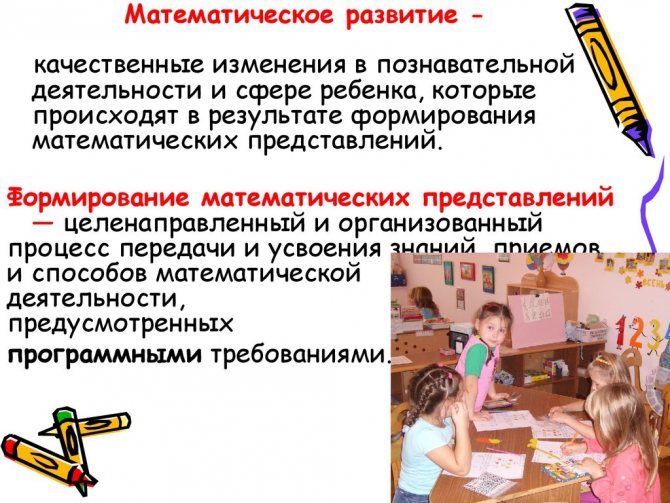
The essence of mathematical development
Numbers, quantity, counting
Children get acquainted with the numbers 0...20, learn to write printed numbers in notebooks. They learn to count within 20, using ordinal numbers (second, fifth). Learn to compare adjacent numbers. Get acquainted with such concepts as less, more, the same amount. Convert equalities into inequalities and vice versa. Get acquainted with the mathematical signs + - = < >. They learn to compare numbers, figures, and the number of objects up to 20. They learn to count by 2s and 3s within 21. They study the composition of the number of the first ten. They come up with problems based on drawings and solve them based on clarity.
Orientation in space
1) Preschoolers learn to determine the position of objects in space - right, left, below, above.
2) Determine the direction of movement - from right to left, from top to bottom, back, forward, in the opposite direction, in the same direction;
3) Get acquainted with the concepts - close and far, low and high, closer, further, nearby.
4) Determine their position in space - outside or inside. Among the objects: on, in, under, over, in front of, between, to, from, through.
5) Orient themselves on a piece of paper, in a column and line of cells.
What methods are best used to develop a preschooler's mathematical understanding?
The visual method plays the most important role in teaching children mathematics, especially when it comes to the early preschool period.

Methods for developing mathematical knowledge
There are the following types of visual teaching methods:
- Working with handouts or demonstration materials. Using a plotless or plot method (you can take as a basis the plot of any fairy tale familiar to a child, where counting or numbers would appear)
- Volumetric or planar. Classes using special counting materials (for example, children's abacus, sticks, cubes, etc.)
- Homemade or factory made.
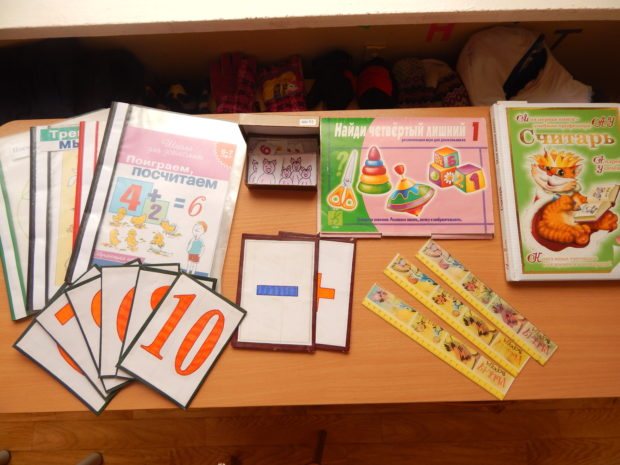
In order to use visual material more effectively, it is necessary to build developmental classes taking into account the following patterns:
- The study of each new topic should begin with more voluminous visual material. This will make it easier for the child to understand
- As the child grows up, it is necessary to ensure that the proportion of volumetric and plot-based visual material decreases, and the proportion of flat and plotless material increases
- It is advisable to use several types of visual material to solve one software problem
- It is very advisable to familiarize the child with new material in advance.
Separately, it is worth considering the requirements for visual aids.
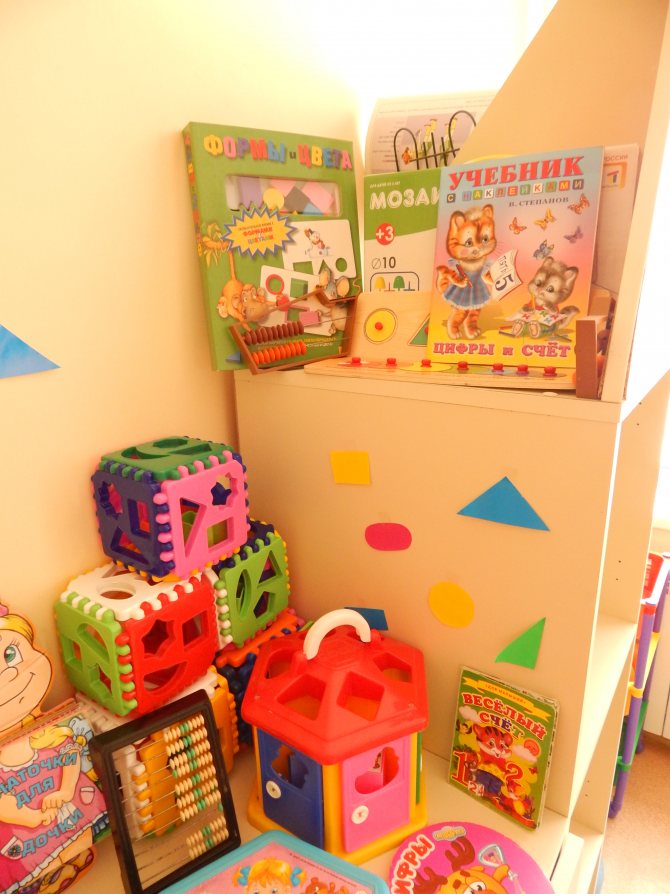
As we have already indicated above, it can be either ready-made at the factory or made by parents. However, it is important that it matches the following:
- Hygiene. Toys must be made from environmentally friendly, safe materials and have all the necessary certificates
- Aesthetics. Attractive material is more likely to attract the child's attention
- A reality that allows a child to perceive the material being studied without distortion
- Durability and reliability
- Variety and sufficient quantity to allow the use of variable techniques
- The principle of logical construction that combines the basics of the material
- Uniformity
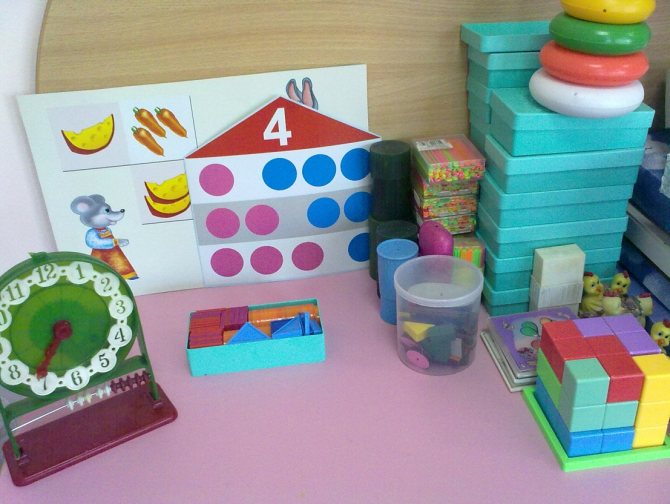
A significant advantage of the practical teaching method is that it most fully explains to the child why he is studying this or that material. And how exactly will the knowledge gained be useful to him in the future?
- Active application in practice of a variety of didactic material
- Performing a variety of both mental and practical activities
- Development of the skill of predicting the outcome of actions with various types of didactic material
- Not only instilling mathematical skills in the child, but also a detailed explanation of their role in the child’s life (in play activities, in everyday life, etc.)
The verbal method of teaching is based on direct interaction between the child and the parent or teacher.
That is why the main requirements for this method will be aimed at the speech of the participants in the process
The speech of the parent or teacher should be:
- Literate
- Rosary
- Emotional and alive
- Available
- Friendly
- Moderately loud
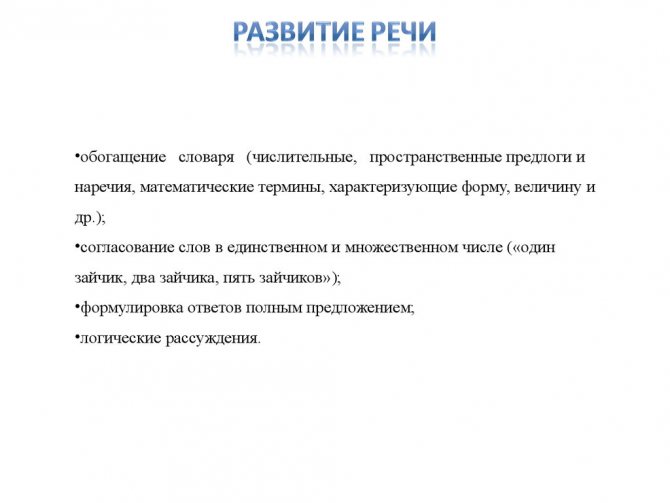
The pace of speech, its intonation and other features must be adjusted depending on the individual age characteristics of the child. For example, a child of primary preschool age perceives rather slow speech much better; unformed memory processes require repeated repetitions.
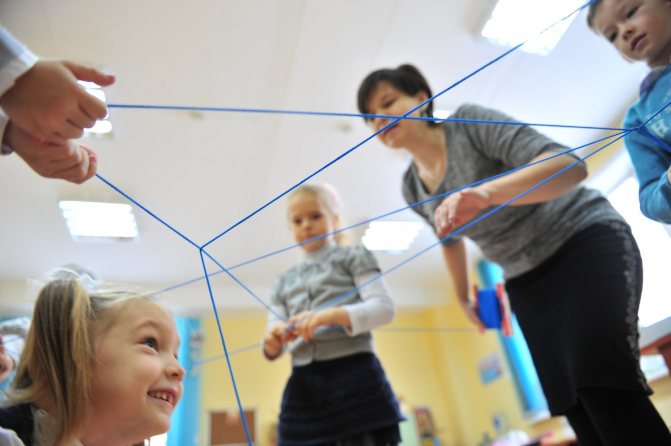
Development of logic and spatial thinking in a playful way
When talking with an older child, you can somewhat speed up the pace of speech and also make more active use of problem situations.
Certain requirements are also imposed on children’s speech. She must be:
- Competent
- Contain the necessary mathematical terminology and basic mathematics by age
- Legible and understandable
- The child must speak in complete common sentences with correct grammatical structure
- Have sufficient volume
Necessary conditions for conducting math classes with a child
What is the theory and methodology of mathematical development for preschoolers based on? In order for the lessons to be truly interesting for the child, and for him to assimilate information faster and easier, they must be built taking into account the following recommendations:
- The use of visual didactic material selected taking into account the age and other individual characteristics of the child
- The presence of a clear plot for the lesson according to which its development will take place
- Selection of tasks in strict accordance with the age characteristics of the child and the level of his intellectual development
- Using a variety of methods and forms to create the basis of work (these include solving logical problems, didactic games, working with handouts, etc.)
- Multitasking (focus on the development of spatial, temporal, quantitative concepts)
- Using a game form of conducting classes
- Emphasis on the formation of gaming motivation; elements of surprise and surprise
- Helping the child not only master a certain system of knowledge and skills, but also develop his skills of independent cognitive activity, independence of judgment, etc.
- Formation of an optimal developmental environment for the development of basic cognitive processes in a child
- Teaching children to perceive the quantitative and qualitative features of objects, forming appropriate ideas
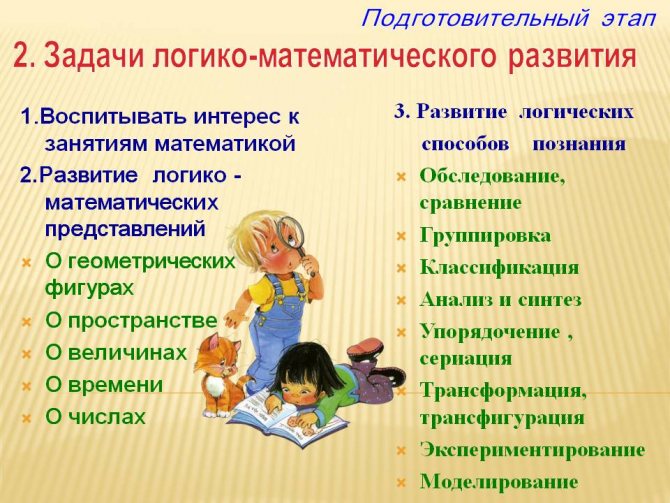
Objectives for the development of mathematical abilities
Formation of elementary ideas about time
In kindergarten, children can actively develop basic knowledge about time. Children should know all four parts of the day, name what time of day they go to bed, and when it is time to get up and go to kindergarten. In this process, a large role is given to the daily routine in the group.
The teacher calls the time of day and says what the children should do now: should they have breakfast, go for a walk, or will they have a nap?
Conversations should be regularly held with children in which parts of the day are mentioned, it is explained why this or that action should be carried out at a certain time of the day (sleep - at night, wash and have breakfast - in the morning, walk, have lunch - during the day, in the evening - play with the family, engage in various activities).
